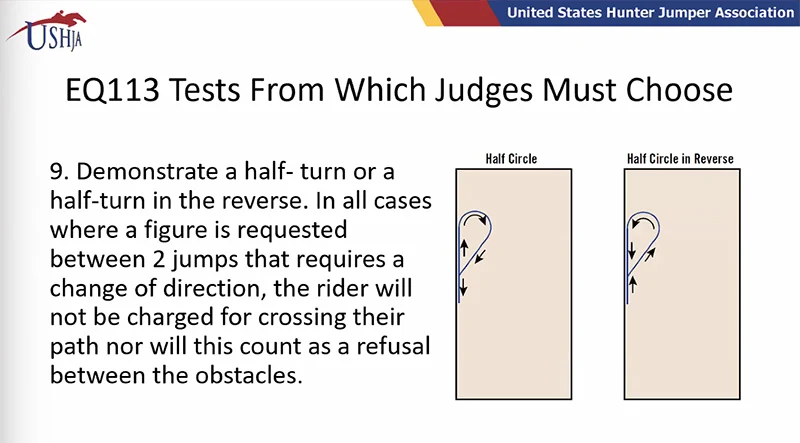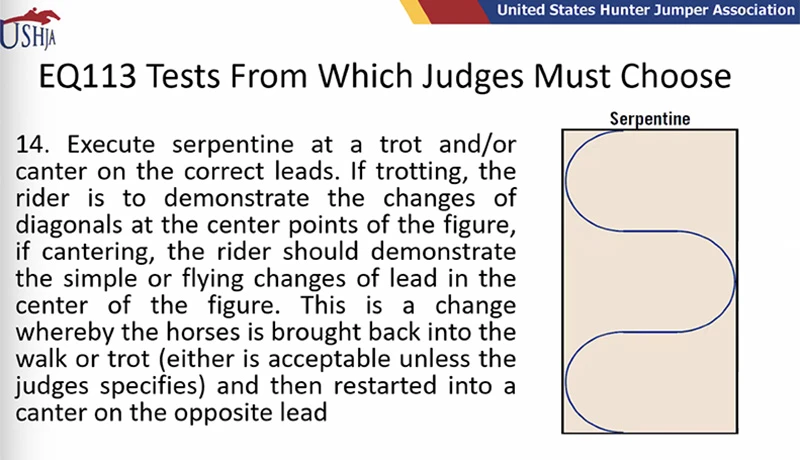Equitation class tests have been expanded and revamped for the new show season that starts Dec. 1. The previous 17 tests from which judges could choose have been expanded to 22 and re-ordered so that they are listed progressively by difficulty. A 23rd test that involves changing horses—reserved for championships—also has been added.
Judges Robin Rost Brown and Tony Sgarlata hosted a webinar with the U.S. Hunter Jumper Association this week to discuss the new tests and provide clarity. The webinar, held Nov. 28, will be posted in its entirety on the USHJA website, and all of the tests referred to are listed in the U.S. Equestrian Federation Rule Book, starting on page 645.
Here are some of the top takeaways:
• Figure 8s should start and end with a halt.
While the basics of the tests involving figure 8s have not changed: two equally sized circles with a change of direction in the center (not an infinity sign), the new tests specify that riders must halt in the center before beginning and must halt again in the center once they complete the figure. Both judges agreed that the direction of the first circle did not matter, unless specified by the judge, so riders should use discretion as to which suits their horse better, especially at the canter where a lead change (simple or flying) is required.
• The new tests include serpentines, half turns and striding changes.
Some additional figures have been added to the tests, including serpentines, half turns and half turns in reverse. Since serpentines can be any number of loops depending on the space provided, judges should specify how many they’d like to see.
The half turn and half turn in reverse can be done at any gait, and if done at the canter, the change of lead should be done at the point where the horse’s bend changes.
 Another new test specifies that judges may ask riders to demonstrate collection in a related distance between fences, for example, riding seven strides in a line previously done in six strides. The rule suggests this not be done in lines shorter than 70 feet and specifies that, for safety purposes, riders cannot be asked to leave out a stride in a line.
Another new test specifies that judges may ask riders to demonstrate collection in a related distance between fences, for example, riding seven strides in a line previously done in six strides. The rule suggests this not be done in lines shorter than 70 feet and specifies that, for safety purposes, riders cannot be asked to leave out a stride in a line.
ADVERTISEMENT
• Counter-cantering a single fence now must be done off a curve.
Test 16 now specifies that if riders are asked to counter-canter a single fence, it must be done off a turn or bend not less than 90 degrees and no more than 120 degrees. This clarification ensures riders truly demonstrate a counter-canter.
“Oftentimes if you had an outside line to a diagonal line and you said counter-canter one of the jumps on the diagonal, they would simple canter the correct lead around the turn and then do a simple change and then on a straight line, off they go and canter to the diagonal jump, so that’s what they’re trying to avoid here,” said Sgarlata. “They just want to have clarity that you would canter through a turn at least.”
It also specifies that the counter-canter can be achieved by simple change, flying change or by landing the lead. Judges cannot require riders to land the lead.
• New rules govern horse swaps.
In addition to limiting horse swaps to championships only, there are three new stipulations for how changing horses must be conducted:
First, riders can only be asked to jump a course, or portion of a course, that they previously completed on their own horse. Previously, the rule only specified that the same obstacles had to be used but no specific order. Second, if the previous course included other tests—for example counter-canter or hand galloping a fence—those tests are excluded for the horse swap. Third, riders must be given at least 90 seconds to do a brief flat and jump no more than two schooling fences on the unfamiliar horse before performing the test.
• Clarifying how faults are scored.
Although not a rule change, the webinar panelists spent time discussing rule EQ108.1J, which is often a point of confusion for riders and trainers. The rule mentions deductions for when a riders either encounters difficulty or fails to complete a test.
If a rider does not perform part of the test—such as forgetting to halt at a specified point—a score of 50 is awarded. If a rider attempts the test, but encounters difficulty—such as losing the counter lead, or being unable to get their horse to stand in the halt—the judge may deduct up to 10 points from the overall score for each problem, depending on its severity.















